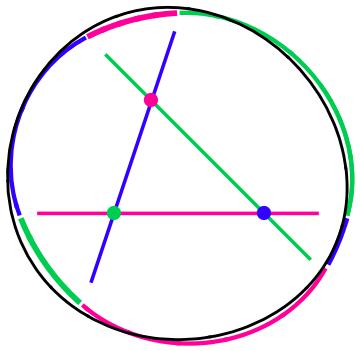Common-or-Garden Ellipses
In an earlier post we saw how a gardener may set out oval flower-beds using a well-known property of ellipses: the sum of the distances from any point on the ellipse to the two foci is always the same value, , the length of the major axis. The gardener puts down two stakes and loops a piece of rope around them. Using a stick, he pulls the loop taut, marking the points around a curve. This is illustrated here.

Definition of an n-Ellipse
A circle with centre at and radius
is defined by the `level set’
where
is an arbitrary point on the circumference. For an ellipse with foci at
and
we have
More generally, we consider a set of foci and define the distance sum
The set of points for which
, the level set, is called an
-ellipse. Thus, a 1-ellipse is a circle and a 2-ellipse is a standard common-or-garden ellipse.
Drawing a 3-Ellipse
Suppose we have three fixed points, the foci of a 3-ellipse. Once the distance sum to the three foci is fixed, the curve is fully determined. However, it has to be computed numerically. Here, we consider a rough-and-ready way of approximating the 3-ellipse.
We imagine a loop of rope around three stakes. If it is drawn tight by a stick that is moved around, a curve is traced out, as in the gardener’s method. However, the result will not be a single mathematical curve. The rope can be taut around two stakes or three. As the stick moves around, different sets of two or three stakes act to constrain the rope.
The result is a closed curve with six different segments joined up smoothly but not analytically. Each segment is the arc of a different ellipse. Let the three foci be represented by the three vertices of a triangle. For each of the three pairs, there is a family of ellipses. Two members of each family are shown here.

We can select elliptical arcs from the three families that, together, form a smooth curve (whose tangent varies smoothly with arc-length). Such a selection is shown here.

Finally, we compare the curve constructed piece-wise with the true 3-ellipse. The elliptical arcs are shown in blue, green and magenta, while the analytical curve is in black. The agreement between the two curves is reasonably close.

Of course, the gardener’s method will not work unless all the foci are within the n-ellipse. Can it be modified to cater for the case of one or more foci outside the curve?
Notice
Booking is open for an evening course, Sum-enchanted Evenings, in University College Dublin. Book online at http://www.ucd.ie/all/study or by phone (01 7167123).
